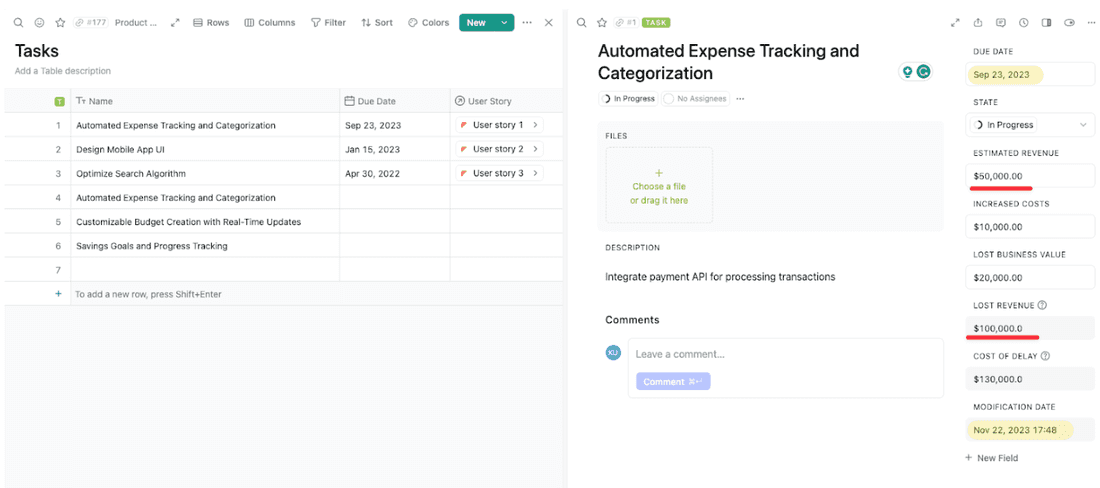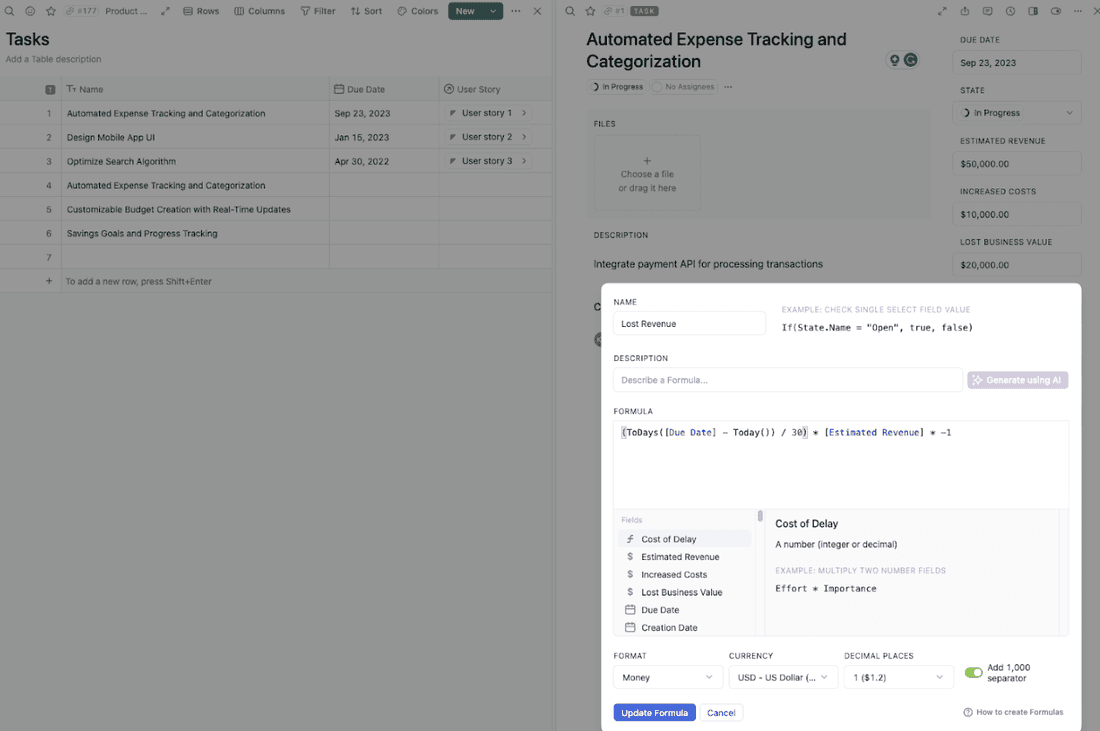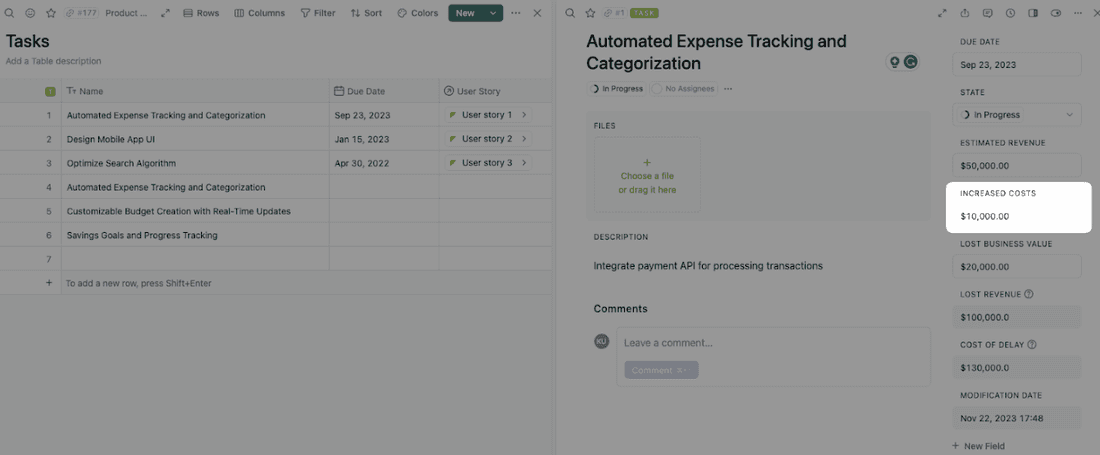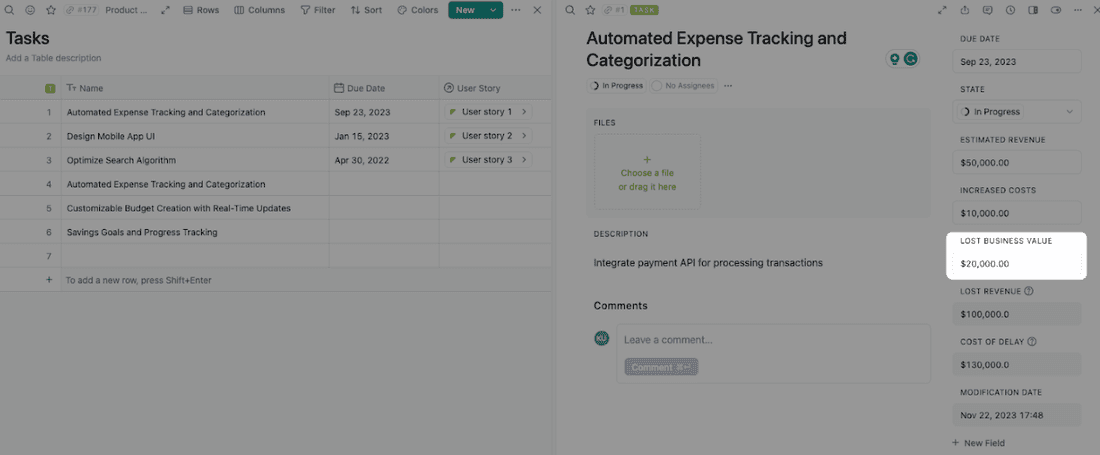Cost of Delay Formula: How to Apply It to Your Product Management
Sometimes, you just know a certain feature will make your product POP!
It’s a great feeling – but it’s not enough to convince the company decision-makers. Especially when they think another feature will be a better choice.
To find the middle ground, you can either try to convince your boss about the accuracy of your subconsciousness – or use a universal business language:
Money.
In this article, we’ll show you how to do the latter, using Cost of Delay – a prioritization framework that lets you see how much money your intuition can make for the company.
What is Cost of Delay?
Cost of Delay (CoD) is a prioritization framework that helps you calculate and compare the cost of the project done now vs. later.
Sounds confusing, doesn’t it? Let’s simplify:
Say you’re planning the work for the upcoming quarter. You have too many tasks in your backlog (of course), but you know you can’t do everything at once, so you start prioritizing the work.
But here’s the problem. How do you decide if task A is more urgent than task B?
Shooting in the dark isn’t a good idea. If a key stakeholder asks, you don’t want to respond: “I had a gut feeling.”
Cost of Delay uses a relation between the benefit/value of a project and the consequences of delaying it. This way, you can organize the work, starting from the most valuable and urgent tasks.
What’s the math behind it? Let’s see:
How is Cost of Delay calculated
Here’s a quick formula to estimate the Cost of Delay:
Cost of Delay = Lost Revenue + Increased Costs + Lost Business Value
Lost Revenue is the revenue you would have earned if the project or product had been delivered on time. It’s calculated based on the expected revenue generation over the delayed period.
Increased Costs are additional costs incurred due to the delay, such as increased labor costs, materials costs, or penalties for late delivery.
Lost Business Value includes less tangible factors such as lost market opportunity, decreased customer satisfaction, or damage to your brand’s reputation, which can have long-term financial impacts.
Let’s say your team is developing a new feature for your app that is expected to generate $50,000 a month once launched.
If you delay the projects by two months:
- You’ll lose $100,000 of revenue:
Lost Revenue = $50,000 * 2 months

Here, we added a separate formula in Fibery that automatically calculates the revenue lost, using the number of months between your due date and today:

This helps you simplify the math and gives you a deeper understanding of the revenue loss over time.
- The development cost will increase because of labor costs, additional rent for the office, etc. Suppose we estimate the extra amount at $10,000. This is a one-time cost, so you don’t need to do math here.

- The loss of business value is harder to quantify, but for the purpose of this example, let’s imagine your competitor gained a bigger market share because of your delay. Your loss here was $20,000:

The total Cost of Delay would be:
Cost of Delay = $100,000 + $10,000 + $20,000 = $130,000
Instead of calculating it manually, we added another formula which does the job for us:

So, if you delay your project by just two months, you will have to deal with an additional, $130,000 cost (ouch!).
CoD quickly helps you visualize the financial impact of any delays in the project and helps you prioritize tasks and resources to minimize any losses for the company.
But, as you probably noticed, you need to do a bit of “eye-balling” with the Increased Costs and Lost Business Value to get the final Cost of Delay.
How accurate is it, then? And when will it work best?
The upsides and downsides of Cost of Delay
Cost of Delay is a powerful framework – but only if you know how far you can go with it.
Here are the pros and cons of CoD you should keep in mind while implementing it in your decision-making:
Pro #1: Enhances Decision-Making
CoD attaches a financial figure to your delays, which helps in two cases. First, you immediately see the most urgent tasks to complete and can quickly decide on the next steps to take.
But most importantly, CoD is a bargaining chip when multiple stakeholders have varying opinions about the priorities.
This is especially useful for Product Managers who often face urgent requests for new features from executives or investors.
If you don’t have a clear reason to stick to your plan – how else could you turn down such a request (and not cause havoc during the meetings)? Cost of Delay shows everyone the economic impact of delaying your current work, so it’s great at convincing leadership not to change plans.
Pro #2 Improves Resource Allocation
As Bruce McCarthy, Product Manager, and author of Roadmaps Relaunched, says:
“We have a particular type of customer that we’re trying to serve and we are trying to solve their biggest problems in a way that makes us money. That’s a complex problem of finding the overlap in multiple different areas, not to mention things that a team can reasonably do technologically.”
When you understand the financial impact of delays, you can assign more team members to a project with the highest estimated value.
This way can be more effective than spreading out product development resources across multiple features, some of which your customer may not care about at all.
Pro #3: Speaks clearly to stakeholders
We already mentioned how to use CoD to deny random requests from stakeholders. But you can also use this prioritization framework to get them to say “Yes!” to your plans.
Cost of Delay highlights the most tangible metric in any business – money.
When you present your product roadmap alongside your CoD analysis, everyone on the team understands the quantifiable impact of working on the new initiative. This leads to an early buy-in across multiple stakeholders and teams in the company.
Now, let’s look at cases where using CoD isn’t the most effective for prioritization:
Con #1: Requires complex calculations
Determining the exact financial impact of delays is complex because it requires knowledge from multiple business areas. The lost business value or increased costs may vary, depending on who is calculating them.
To overcome this, you should gather insights from multiple departments. Ask the Sales team about how a release delay might impact sales forecasts. Consult with Marketing about how the delay might impact campaign performance.
Aligning many departments toward the same goal can later help discuss the project with the executives, too.
Con #2: May overemphasize short-term gains
The focus on the monetary aspect of CoD is a double-edged sword. If you focus only on the financial gains, you may overlook the long-term strategic goals with lower immediate benefits.
Another perspective you should keep in mind is each task’s long-term influence on the overall product’s performance. Just because a certain task seems valuable now, does it mean it’ll be as important in the future?
Think of how many companies started implementing AI into their tools after OpenAI’s massive success. Many of those implementations weren’t necessary, leading to complaints from customers.
Con #3: Depends on accurate data
CoD relies heavily on the accuracy of your data about the project’s value and time.
If you have gaps in your knowledge about crucial performance metrics for your project, it’ll be tough to calculate an accurate value (let alone justify it to someone).
And, considering how much work you’ll have to put in to gather all this data, using Cost of Delay to rank a couple of action items might be inefficient.
Only use the Cost of Delay in product management when you:
- Have a long list of tasks to prioritize fast
- Want to justify your roadmap planning to your stakeholders quantitatively
- Are confident about each initiative
The PM’s hot take
If you are working in a high-performing environment, bringing value to the table is quintessential. This makes CoD a reliable prioritization technique: you and your org will start making transparent, and more rational economic decisions. Just keep in mind: no matter how much we love relying on numbers, they can be deceptive. Check your data twice and make sure those calculations add up before building an entire roadmap on faulty calculations.
Conclusion
While CoD can be an excellent tool for prioritizing projects, PMs shouldn’t rely on this framework alone. Mix quantitative tools like CoD with qualitative assessments to understand the unique dynamics of each project, the organization’s strategic goals, and the stakeholders’ needs.
And if you need a clean space to organize it all, we prepared a free Product Management template to help you get started.
Psst... Wanna try Fibery? 👀
Infinitely flexible product discovery & development platform.